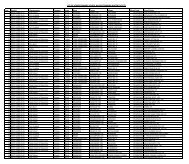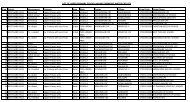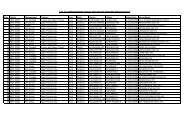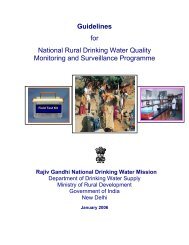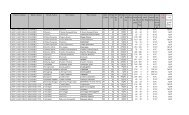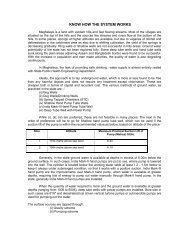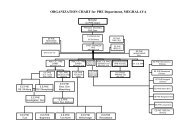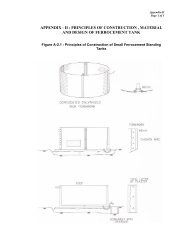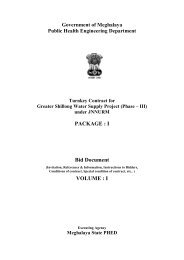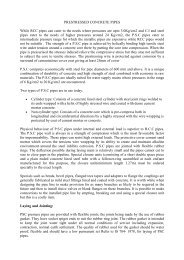PACKAGE : I Bid Document VOLUME : II - Public Health Engineering
PACKAGE : I Bid Document VOLUME : II - Public Health Engineering
PACKAGE : I Bid Document VOLUME : II - Public Health Engineering
Create successful ePaper yourself
Turn your PDF publications into a flip-book with our unique Google optimized e-Paper software.
18.3 Site preparation:<br />
Preliminary work required to be done before pipe laying is started, includes pegging<br />
out, clearing and disposal of all shrub, grass, large and small bushes, trees, hedges,<br />
fences, gates, portions of old masonry and debris from the route.<br />
Where trees have been felled, the resulting timber shall be stacked properly and<br />
disposed off as directed by the Engineer-in-charge. Tree roots within a distance of<br />
about half metre from the side of the pipe line shall be removed or killed.<br />
All other serviceable materials, such as wood work, bricks and masonry, recovered<br />
during the operation of clearing the site shall be separately stacked and disposed off<br />
as directed by the Engineer-in-charge.<br />
Formation:<br />
1. Before pipe line is laid, proper formation shall be prepared. For underground<br />
pipe-line, suitable trenches should be excavated, pipe line above ground may be laid<br />
in cutting or on embankments or be supported by pillars as the case may be.<br />
2. Excavation and preparation of trenches for laying underground pipe line. The<br />
trench shall be so dug that the pipe may be laid to the required alignment and at<br />
required depth. When the pipe line is under a roadway, a minimum cover of 1.2 m<br />
is recommended, but it may be modified to suit local conditions by taking necessary<br />
precautions. The trench shall be shored, wherever necessary, and kept dry so that<br />
the workman may work therein safely, and efficiently. The discharge of the trench<br />
dewatering pumps shall be conveyed either to drainage channels or to natural<br />
drains, and shall not be allowed to be spread in the vicinity of the work-site.<br />
(a) Trenching : Trenching includes all excavation which is carried out by hand or<br />
by machine. The width of the trench shall be kept to a minimum consistent with the<br />
working space required. At the bottom between the faces, it shall be such as to<br />
provide not less than 200mm clearance on either side of the pipe. Each case should,<br />
however, be considered on its merits, having regard to the safety of the trench the<br />
method of laying and jointing the pipe and the need to avoid damage to pipe<br />
coating. The bottom of the trench shall be properly trimmed to permit even bedding<br />
of the pipe line. Where rock or boulders are encountered, the trench shall be<br />
trimmed to a depth of at least 100mm below the level at which the bottom of the<br />
barrel of the pipe is to be laid and filled to a like depth with lean cement concrete or<br />
with non-compressible material like sand of adequate depth to give the curved<br />
seating.<br />
DTS : Detailed Tender Specification. Page 166



